Detailed Analysis of Accounting Systems and Processes Report
VerifiedAdded on 2019/10/30
|27
|1903
|135
Report
AI Summary
This report delves into various aspects of accounting systems and processes. It begins by explaining cell naming in spreadsheets, the representation of negative numbers, and the importance of separating data and report areas. The report then explores IF functions, periodic inventory systems, and the use of spreadsheets for financial reporting, including formula views and normal views. It further examines journal entries using both the direct write-off method and the allowance method. The report also includes an analysis of a firm's financial position, including analytical measures, followed by journal entries for different financial transactions. Finally, it concludes with a case study on Wesfarmers Limited, covering its comprehensive income statement, dividends, return on equity, risk mitigation, sustainability, and corporate governance, alongside advice for investment. The report uses several financial concepts such as working capital ratio and net profit after tax to support the analysis. The report is contributed by a student and is available on Desklib, a platform providing AI-based study tools.

Running head: ACCOUNTING SYSTEMS AND PROCESSES
Accounting systems and Processes
Name of the Student:
Name of the University:
Author Note:
Accounting systems and Processes
Name of the Student:
Name of the University:
Author Note:
Paraphrase This Document
Need a fresh take? Get an instant paraphrase of this document with our AI Paraphraser
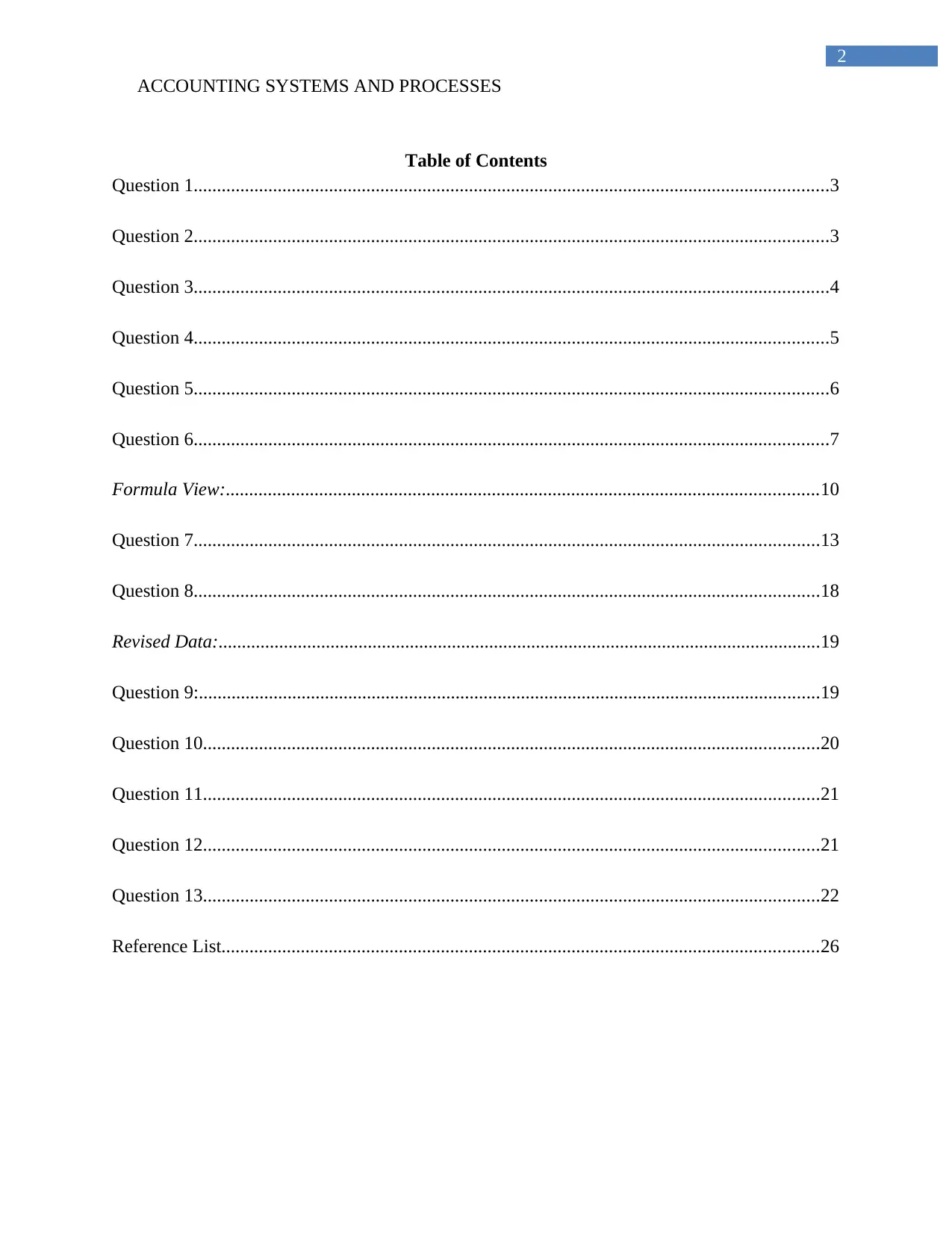
2
ACCOUNTING SYSTEMS AND PROCESSES
Table of Contents
Question 1........................................................................................................................................3
Question 2........................................................................................................................................3
Question 3........................................................................................................................................4
Question 4........................................................................................................................................5
Question 5........................................................................................................................................6
Question 6........................................................................................................................................7
Formula View:...............................................................................................................................10
Question 7......................................................................................................................................13
Question 8......................................................................................................................................18
Revised Data:.................................................................................................................................19
Question 9:.....................................................................................................................................19
Question 10....................................................................................................................................20
Question 11....................................................................................................................................21
Question 12....................................................................................................................................21
Question 13....................................................................................................................................22
Reference List................................................................................................................................26
ACCOUNTING SYSTEMS AND PROCESSES
Table of Contents
Question 1........................................................................................................................................3
Question 2........................................................................................................................................3
Question 3........................................................................................................................................4
Question 4........................................................................................................................................5
Question 5........................................................................................................................................6
Question 6........................................................................................................................................7
Formula View:...............................................................................................................................10
Question 7......................................................................................................................................13
Question 8......................................................................................................................................18
Revised Data:.................................................................................................................................19
Question 9:.....................................................................................................................................19
Question 10....................................................................................................................................20
Question 11....................................................................................................................................21
Question 12....................................................................................................................................21
Question 13....................................................................................................................................22
Reference List................................................................................................................................26

3
ACCOUNTING SYSTEMS AND PROCESSES
ACCOUNTING SYSTEMS AND PROCESSES
⊘ This is a preview!⊘
Do you want full access?
Subscribe today to unlock all pages.

Trusted by 1+ million students worldwide
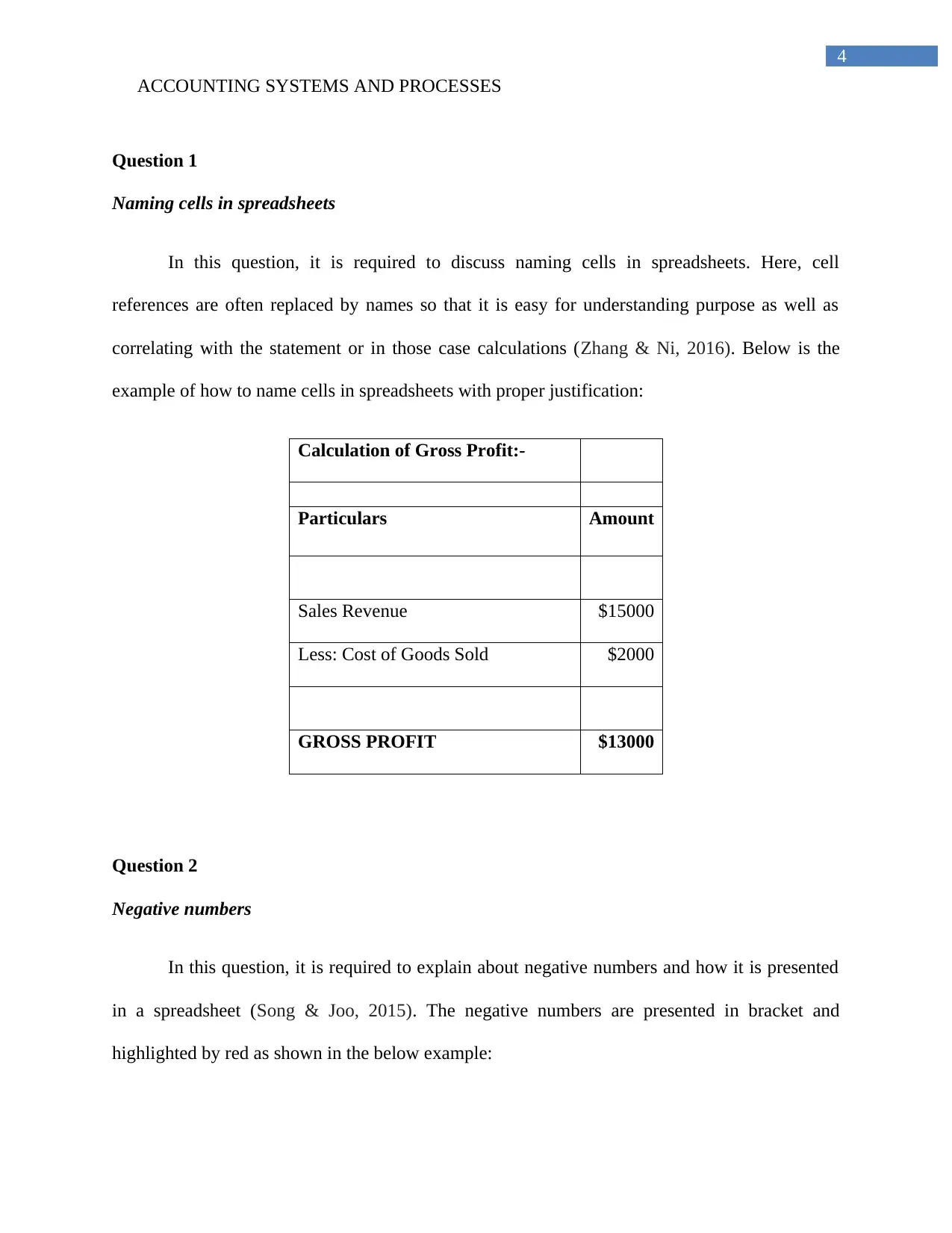
4
ACCOUNTING SYSTEMS AND PROCESSES
Question 1
Naming cells in spreadsheets
In this question, it is required to discuss naming cells in spreadsheets. Here, cell
references are often replaced by names so that it is easy for understanding purpose as well as
correlating with the statement or in those case calculations (Zhang & Ni, 2016). Below is the
example of how to name cells in spreadsheets with proper justification:
Calculation of Gross Profit:-
Particulars Amount
Sales Revenue $15000
Less: Cost of Goods Sold $2000
GROSS PROFIT $13000
Question 2
Negative numbers
In this question, it is required to explain about negative numbers and how it is presented
in a spreadsheet (Song & Joo, 2015). The negative numbers are presented in bracket and
highlighted by red as shown in the below example:
ACCOUNTING SYSTEMS AND PROCESSES
Question 1
Naming cells in spreadsheets
In this question, it is required to discuss naming cells in spreadsheets. Here, cell
references are often replaced by names so that it is easy for understanding purpose as well as
correlating with the statement or in those case calculations (Zhang & Ni, 2016). Below is the
example of how to name cells in spreadsheets with proper justification:
Calculation of Gross Profit:-
Particulars Amount
Sales Revenue $15000
Less: Cost of Goods Sold $2000
GROSS PROFIT $13000
Question 2
Negative numbers
In this question, it is required to explain about negative numbers and how it is presented
in a spreadsheet (Song & Joo, 2015). The negative numbers are presented in bracket and
highlighted by red as shown in the below example:
Paraphrase This Document
Need a fresh take? Get an instant paraphrase of this document with our AI Paraphraser
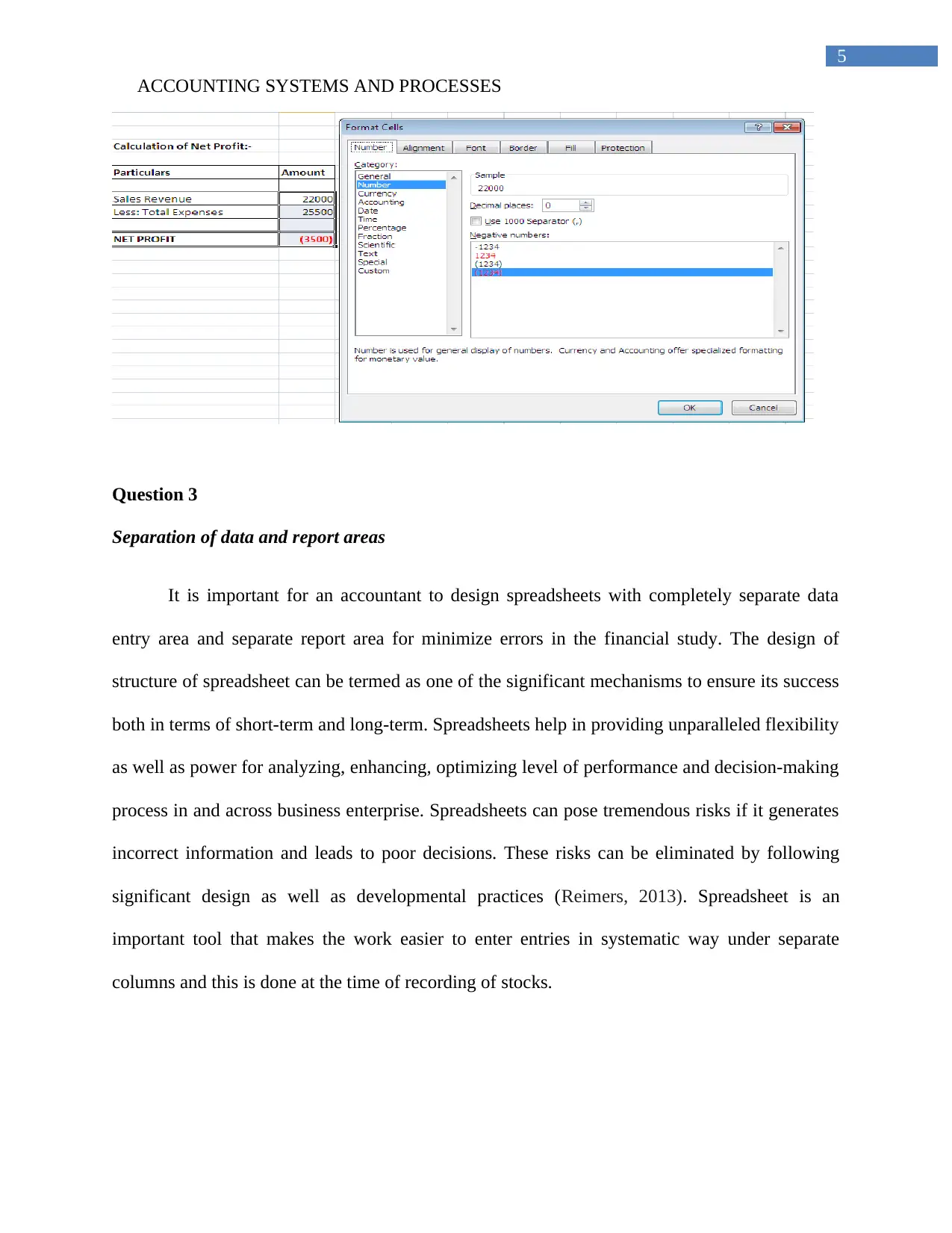
5
ACCOUNTING SYSTEMS AND PROCESSES
Question 3
Separation of data and report areas
It is important for an accountant to design spreadsheets with completely separate data
entry area and separate report area for minimize errors in the financial study. The design of
structure of spreadsheet can be termed as one of the significant mechanisms to ensure its success
both in terms of short-term and long-term. Spreadsheets help in providing unparalleled flexibility
as well as power for analyzing, enhancing, optimizing level of performance and decision-making
process in and across business enterprise. Spreadsheets can pose tremendous risks if it generates
incorrect information and leads to poor decisions. These risks can be eliminated by following
significant design as well as developmental practices (Reimers, 2013). Spreadsheet is an
important tool that makes the work easier to enter entries in systematic way under separate
columns and this is done at the time of recording of stocks.
ACCOUNTING SYSTEMS AND PROCESSES
Question 3
Separation of data and report areas
It is important for an accountant to design spreadsheets with completely separate data
entry area and separate report area for minimize errors in the financial study. The design of
structure of spreadsheet can be termed as one of the significant mechanisms to ensure its success
both in terms of short-term and long-term. Spreadsheets help in providing unparalleled flexibility
as well as power for analyzing, enhancing, optimizing level of performance and decision-making
process in and across business enterprise. Spreadsheets can pose tremendous risks if it generates
incorrect information and leads to poor decisions. These risks can be eliminated by following
significant design as well as developmental practices (Reimers, 2013). Spreadsheet is an
important tool that makes the work easier to enter entries in systematic way under separate
columns and this is done at the time of recording of stocks.
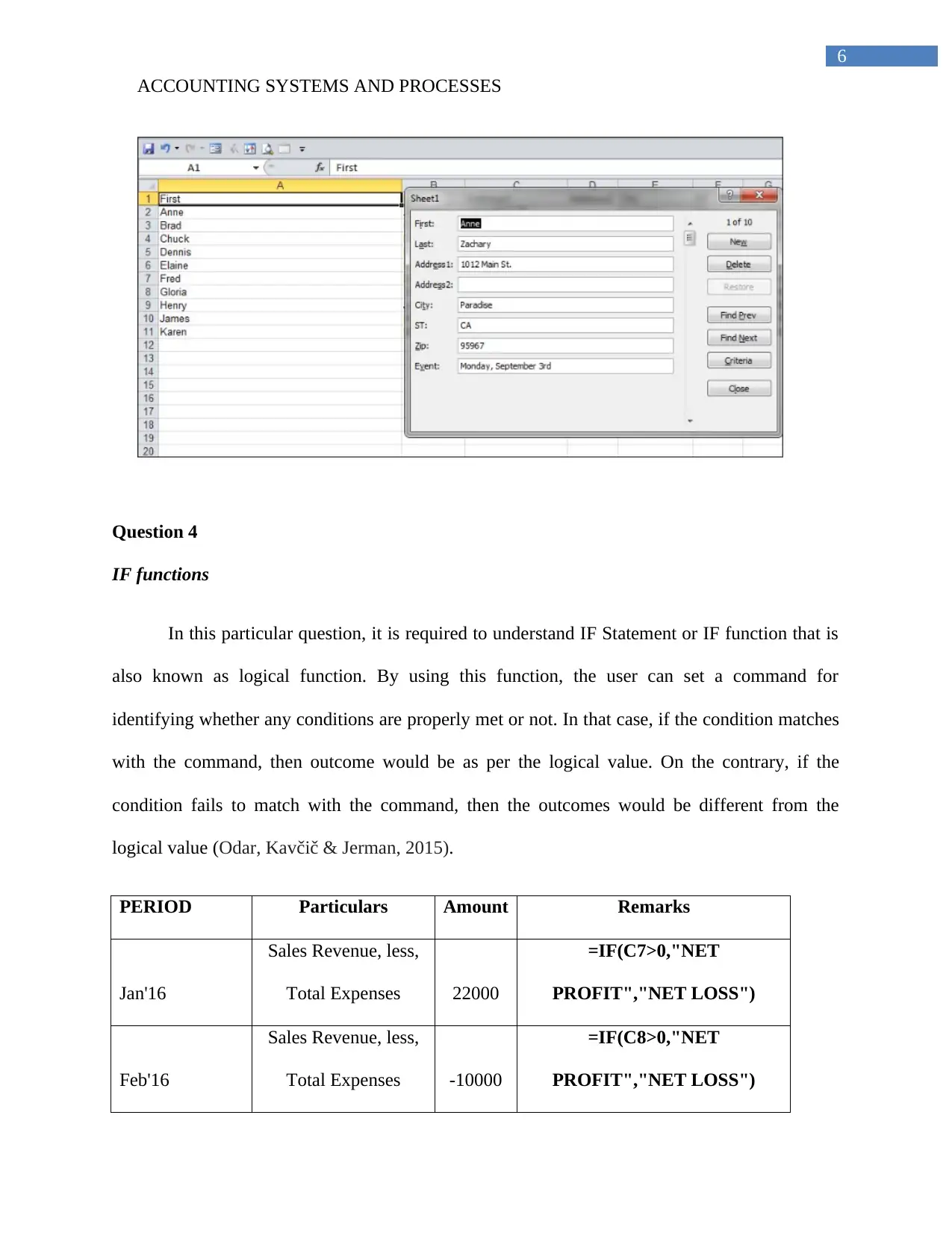
6
ACCOUNTING SYSTEMS AND PROCESSES
Question 4
IF functions
In this particular question, it is required to understand IF Statement or IF function that is
also known as logical function. By using this function, the user can set a command for
identifying whether any conditions are properly met or not. In that case, if the condition matches
with the command, then outcome would be as per the logical value. On the contrary, if the
condition fails to match with the command, then the outcomes would be different from the
logical value (Odar, Kavčič & Jerman, 2015).
PERIOD Particulars Amount Remarks
Jan'16
Sales Revenue, less,
Total Expenses 22000
=IF(C7>0,"NET
PROFIT","NET LOSS")
Feb'16
Sales Revenue, less,
Total Expenses -10000
=IF(C8>0,"NET
PROFIT","NET LOSS")
ACCOUNTING SYSTEMS AND PROCESSES
Question 4
IF functions
In this particular question, it is required to understand IF Statement or IF function that is
also known as logical function. By using this function, the user can set a command for
identifying whether any conditions are properly met or not. In that case, if the condition matches
with the command, then outcome would be as per the logical value. On the contrary, if the
condition fails to match with the command, then the outcomes would be different from the
logical value (Odar, Kavčič & Jerman, 2015).
PERIOD Particulars Amount Remarks
Jan'16
Sales Revenue, less,
Total Expenses 22000
=IF(C7>0,"NET
PROFIT","NET LOSS")
Feb'16
Sales Revenue, less,
Total Expenses -10000
=IF(C8>0,"NET
PROFIT","NET LOSS")
⊘ This is a preview!⊘
Do you want full access?
Subscribe today to unlock all pages.

Trusted by 1+ million students worldwide
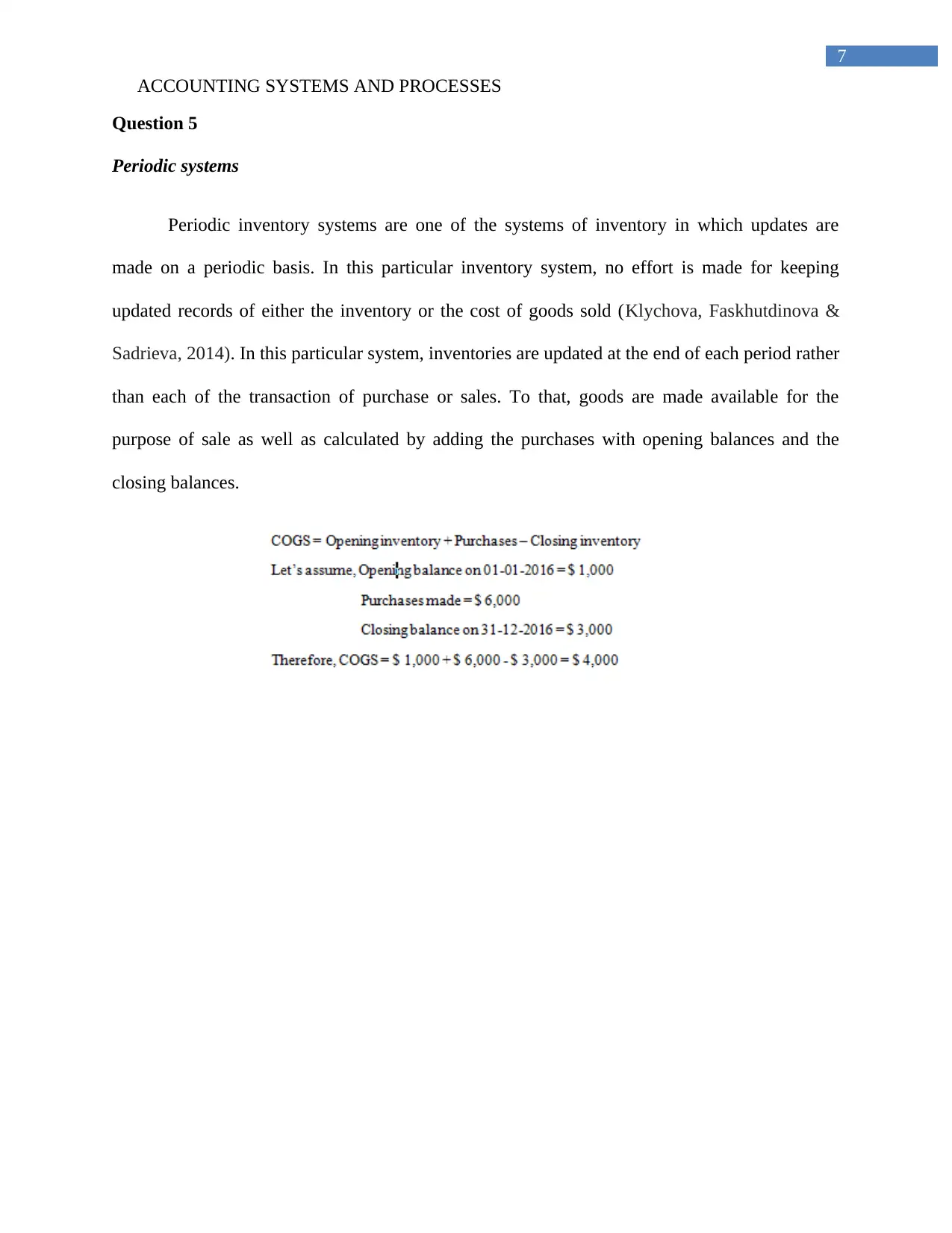
7
ACCOUNTING SYSTEMS AND PROCESSES
Question 5
Periodic systems
Periodic inventory systems are one of the systems of inventory in which updates are
made on a periodic basis. In this particular inventory system, no effort is made for keeping
updated records of either the inventory or the cost of goods sold (Klychova, Faskhutdinova &
Sadrieva, 2014). In this particular system, inventories are updated at the end of each period rather
than each of the transaction of purchase or sales. To that, goods are made available for the
purpose of sale as well as calculated by adding the purchases with opening balances and the
closing balances.
ACCOUNTING SYSTEMS AND PROCESSES
Question 5
Periodic systems
Periodic inventory systems are one of the systems of inventory in which updates are
made on a periodic basis. In this particular inventory system, no effort is made for keeping
updated records of either the inventory or the cost of goods sold (Klychova, Faskhutdinova &
Sadrieva, 2014). In this particular system, inventories are updated at the end of each period rather
than each of the transaction of purchase or sales. To that, goods are made available for the
purpose of sale as well as calculated by adding the purchases with opening balances and the
closing balances.
Paraphrase This Document
Need a fresh take? Get an instant paraphrase of this document with our AI Paraphraser
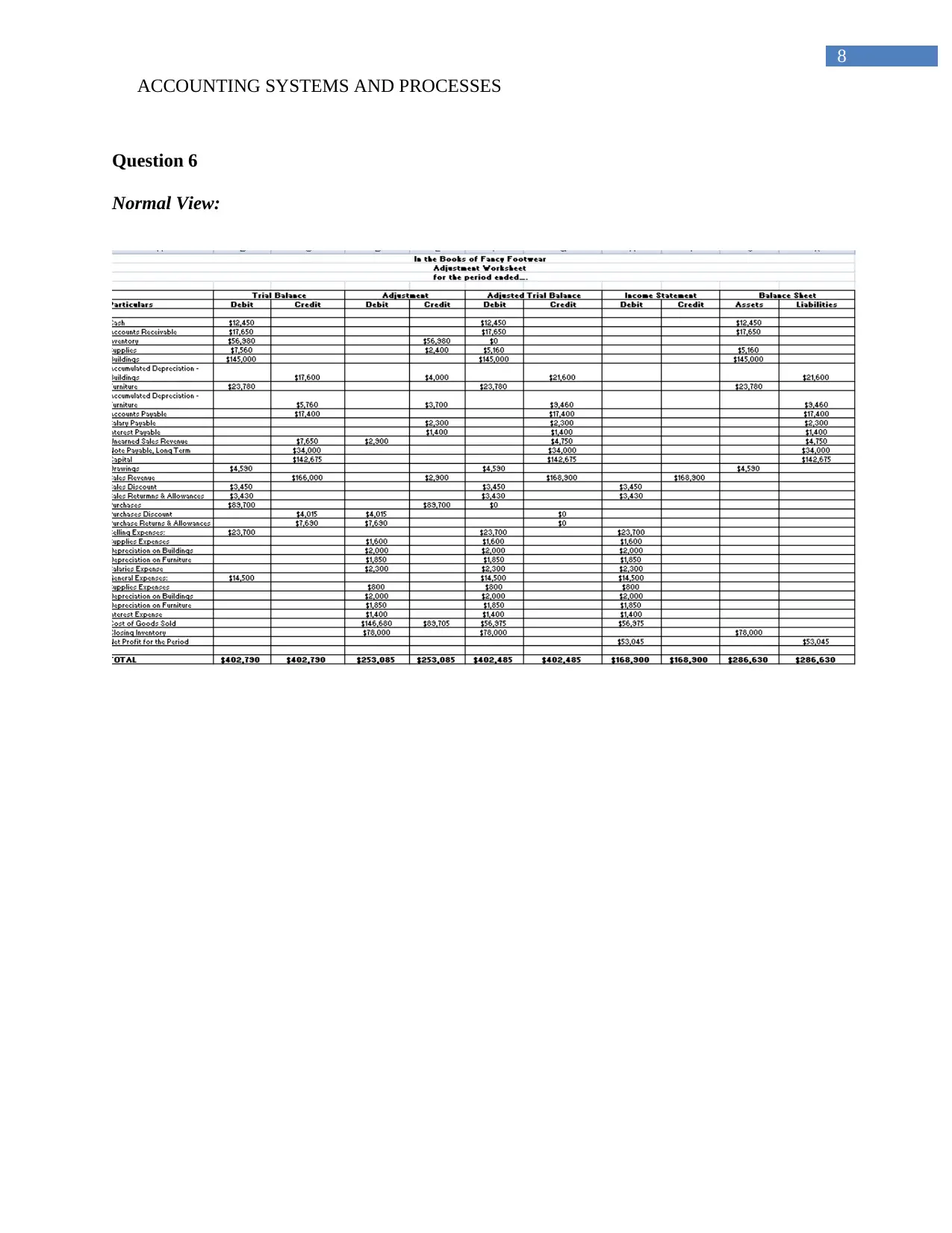
8
ACCOUNTING SYSTEMS AND PROCESSES
Question 6
Normal View:
ACCOUNTING SYSTEMS AND PROCESSES
Question 6
Normal View:
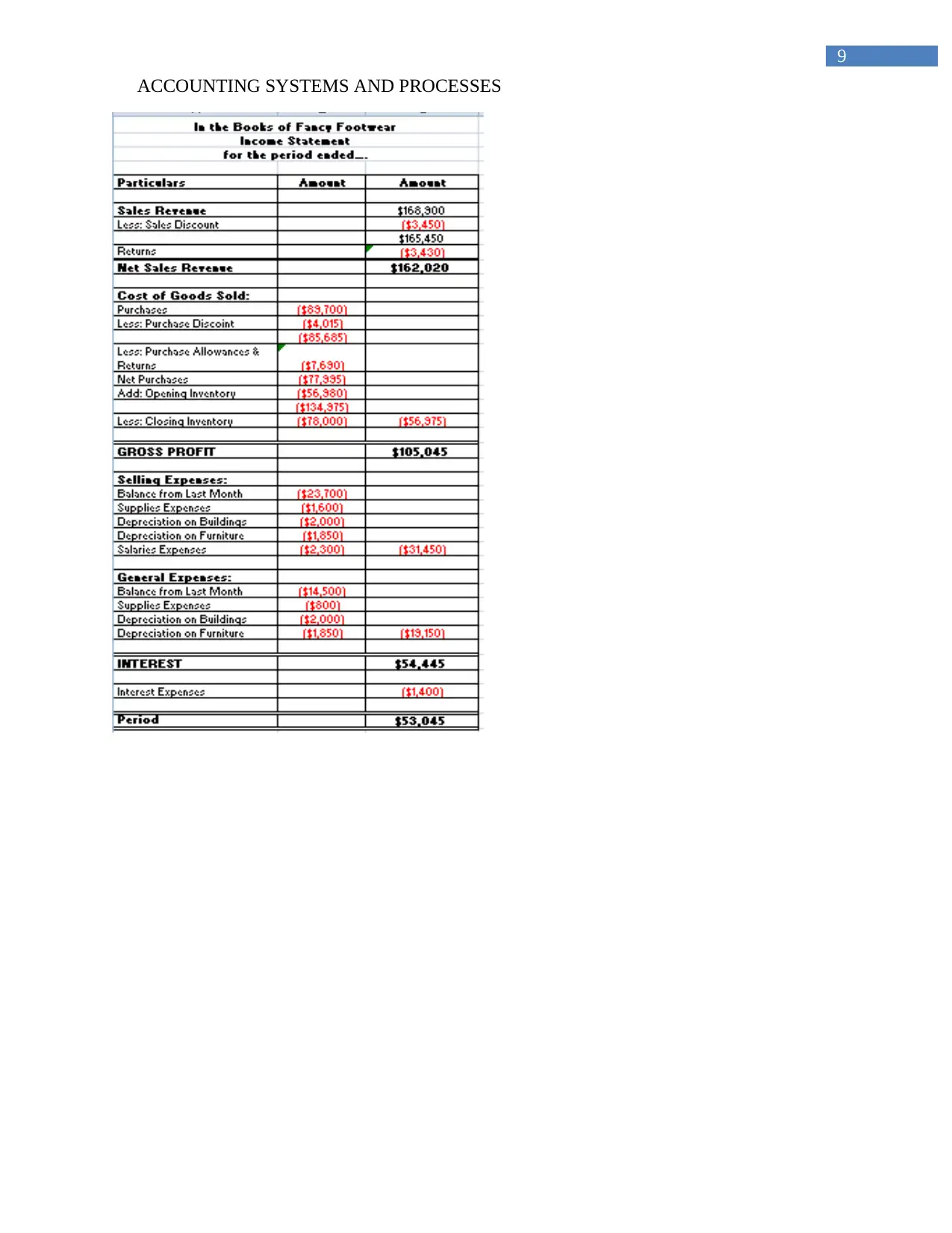
9
ACCOUNTING SYSTEMS AND PROCESSES
ACCOUNTING SYSTEMS AND PROCESSES
⊘ This is a preview!⊘
Do you want full access?
Subscribe today to unlock all pages.

Trusted by 1+ million students worldwide
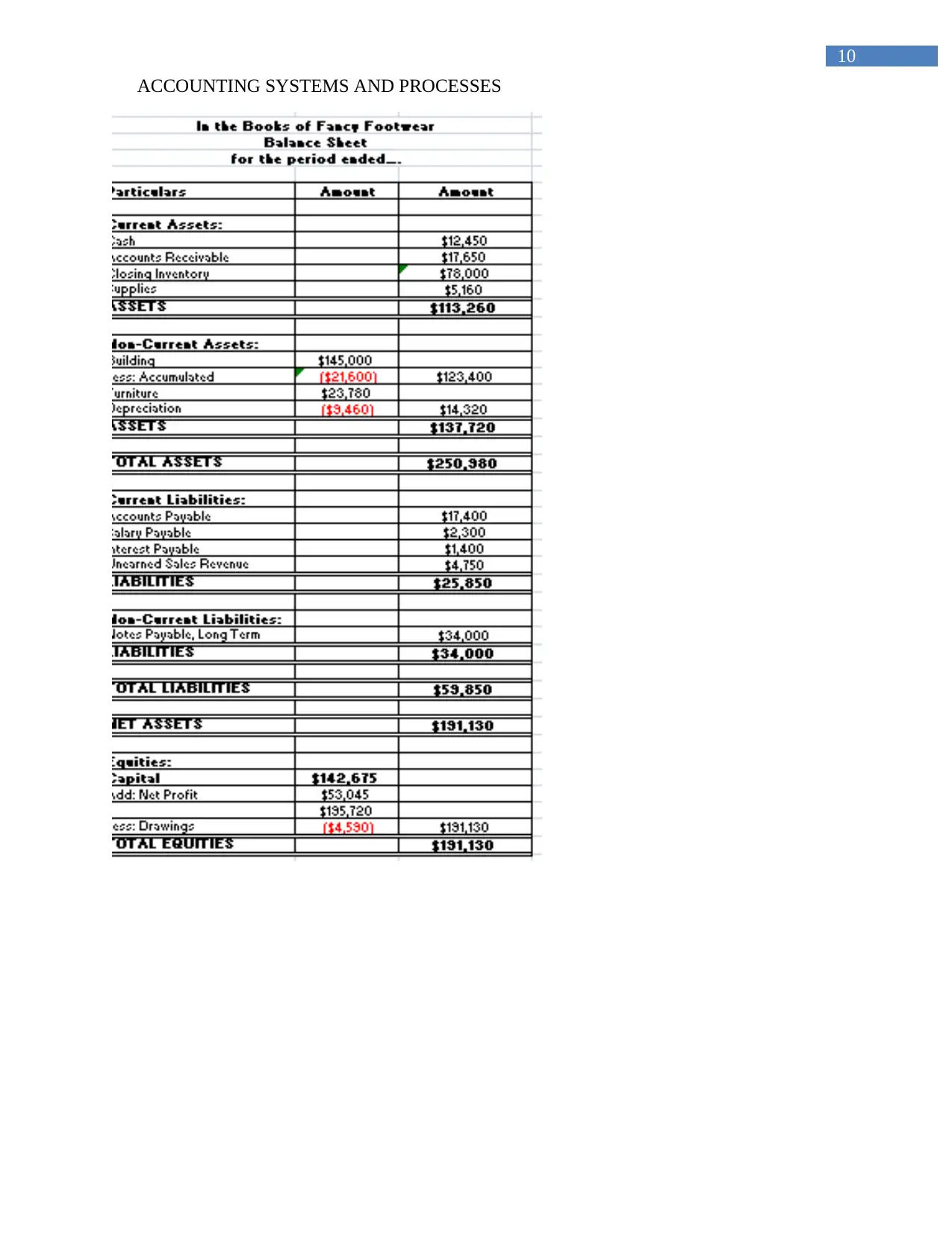
10
ACCOUNTING SYSTEMS AND PROCESSES
ACCOUNTING SYSTEMS AND PROCESSES
Paraphrase This Document
Need a fresh take? Get an instant paraphrase of this document with our AI Paraphraser
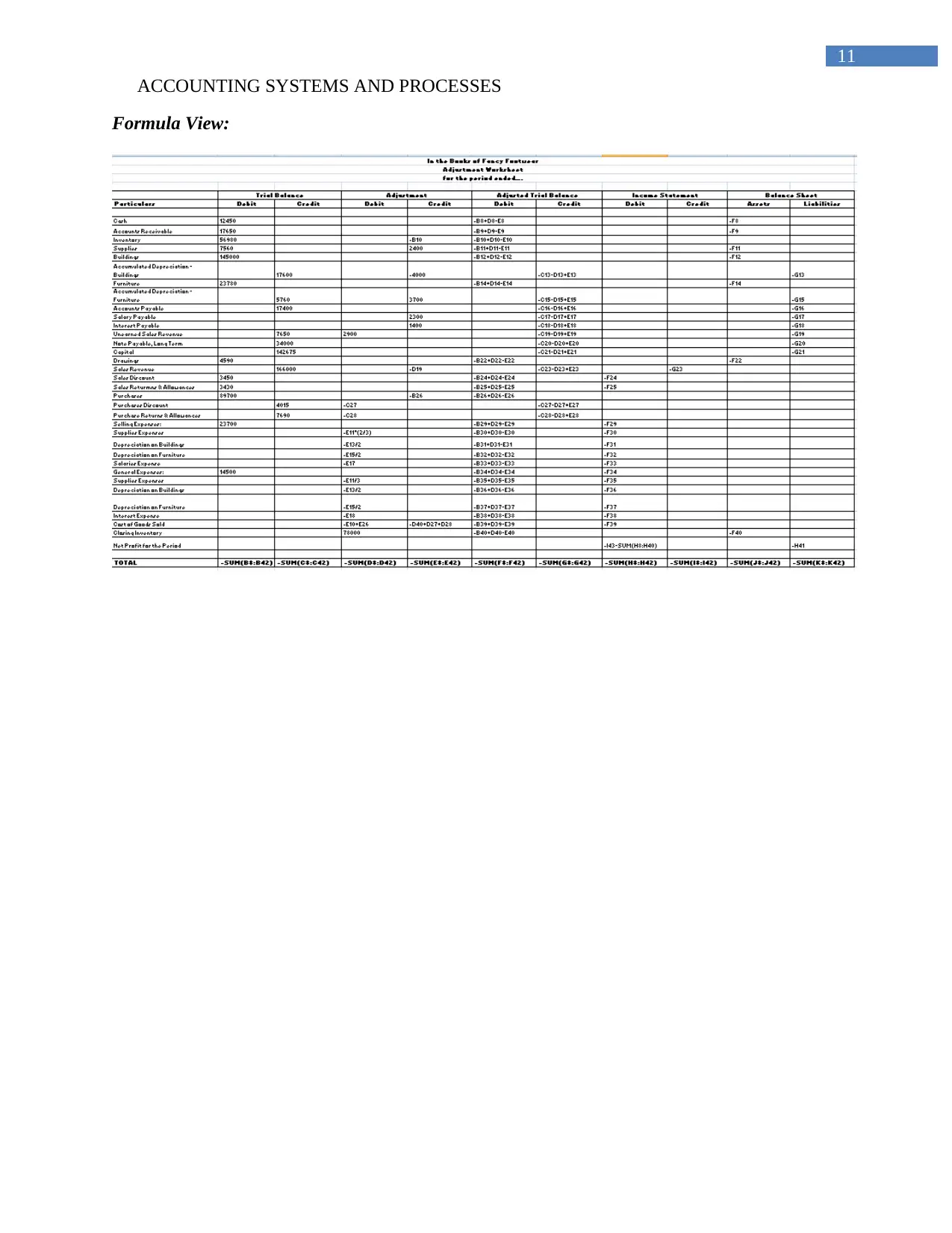
11
ACCOUNTING SYSTEMS AND PROCESSES
Formula View:
ACCOUNTING SYSTEMS AND PROCESSES
Formula View:
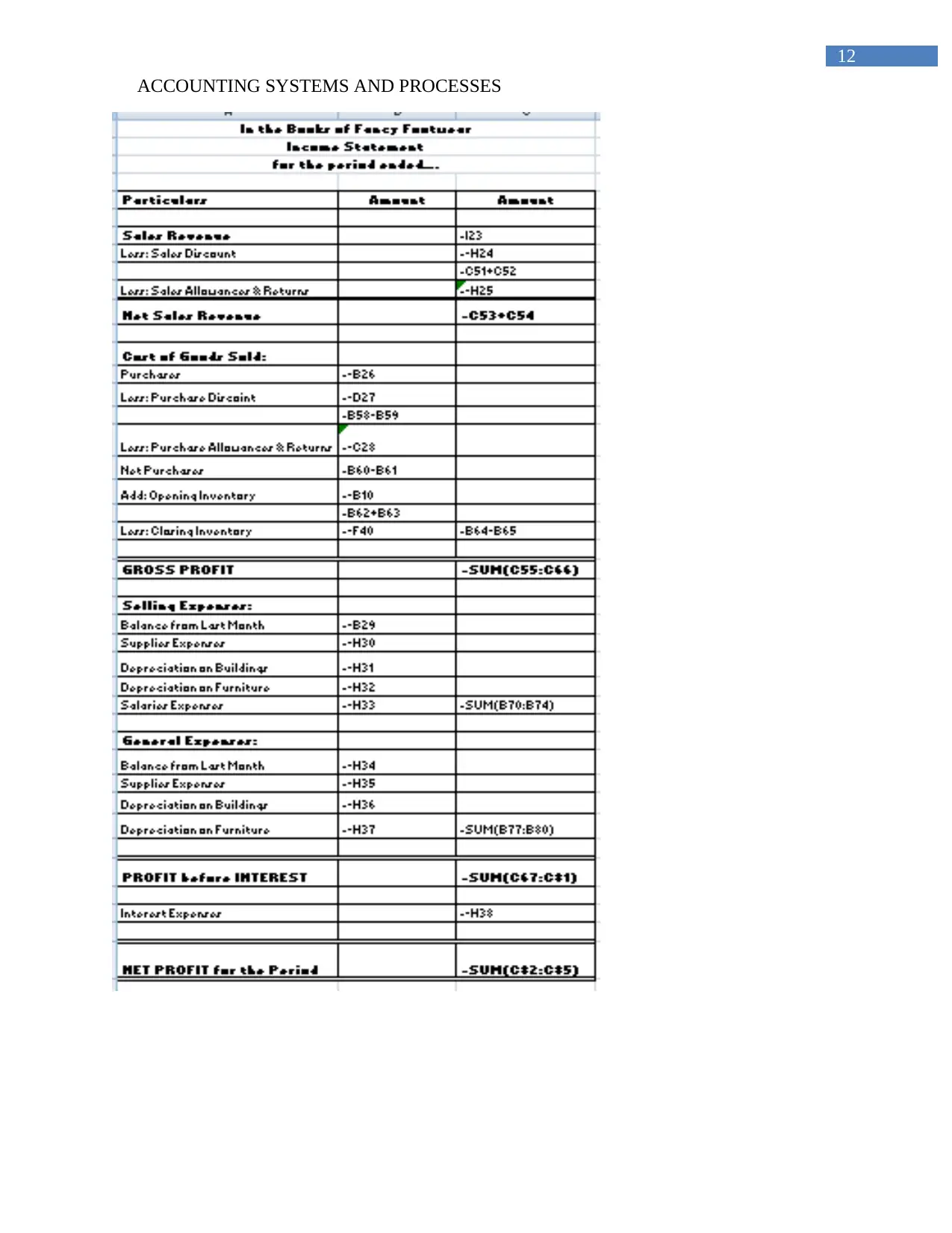
12
ACCOUNTING SYSTEMS AND PROCESSES
ACCOUNTING SYSTEMS AND PROCESSES
⊘ This is a preview!⊘
Do you want full access?
Subscribe today to unlock all pages.

Trusted by 1+ million students worldwide
1 out of 27
Related Documents
Your All-in-One AI-Powered Toolkit for Academic Success.
+13062052269
info@desklib.com
Available 24*7 on WhatsApp / Email
![[object Object]](/_next/static/media/star-bottom.7253800d.svg)
Unlock your academic potential
Copyright © 2020–2025 A2Z Services. All Rights Reserved. Developed and managed by ZUCOL.





